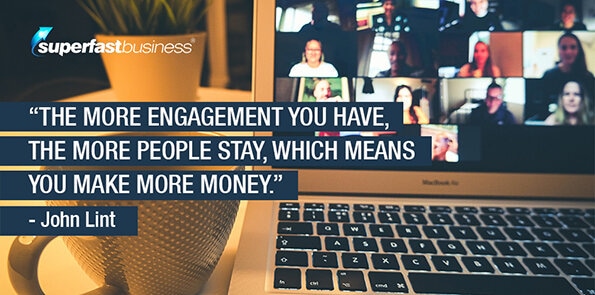Membership owners James Schramko and John Lint have based a whole podcast series on what they do well - membership websites.
Now with the basics out of the way, they let you in on the things that will power up and enhance your subscription business model - things like automating, dashboards, apps and more.
Podcast: Download (Duration: 37:58 — 34.9MB)
Get Notified Of Future Episodes Apple Podcasts | Spotify | Amazon Music | Android | Blubrry | Gaana | TuneIn | Deezer | Anghami | RSS | More
In the episode:
01:10 – What this part of the membership journey is about. Here’s what to expect in today’s episode.
02:30 – Technique number one: automating. The hands-off approach is powerful.
05:37 – The involvement of tools. First, you use these valuable implements.
06:47 – When you stop doing stuff yourself. Business process automation is freedom.
08:48 – Now you can actually stop and think. A lot can be accomplished by not doing.
13:59 – Because everyone’s got a phone… It works for James and John.
19:29 – Do you know what’s happening in your business? Discover how to stay on top of things.
28:33 – This is a number you really want to understand. The survival of your business depends on it.
30:34 – The thing people don’t talk about often. You don’t want to overlook this aspect of your membership.
Take your membership business to new heights with James’s help
If this topic were a chapter in a book on memberships, says James, it would be like Chapter 11. It’s where you’ve got the basics working:
In short, it’s all going great. But what next?
This is the fun part, where you double, quadruple or 10x a membership website that’s already existing and working okay, but is not as good as it could be.
It’s like bringing your Porsche to a shop and fitting it out with all the best in parts and paint job, so that it comes out hot.
Technique number one: automate
Step one in the tune-up process, says James, is to automate whatever is possible. By automating, he means, make something a recurring function in your business that doesn’t involve you. Starting out, you’re likely doing lots of things manually. And that’s okay – it keeps costs low, and you’re still finding your feet. But then you get up and running.
Then it becomes all about scaling, getting more results. Note, says John, results are going to be different for everybody, and any result is good. But now you identify what you’ve done, do more of what’s worked, and then do things that will help you get even more results.
That’s when you leverage two main ways of automation: tools, and team.
The involvement of tools
10XPRO was built to automate tasks. John was doing things in his membership that he didn’t want to keep doing. So he created the all-in-one membership tool that is 10XPRO.
Say you’ve got a great sales campaign that worked great the first time you ran it live. Now with 10XPRO you can put it on autopilot. You can use auto deadline timers that run by themselves, register people automatically when they opt in to a free offer. They each get their own unique deadline, and their own unique experience of your funnel.
When an offer is made, doors open or shut automatically. It’s all about having the right tool. And 10XPRO facilitates any number of automations for memberships.
When you stop doing stuff yourself
In the early days of James’s membership, he would look through his posts and find the ones most commented on. He’d make a summary video, edit it, load it to a video player, and embed it in his membership. Then he’d broadcast an email to his members. He did every step of that himself. He doesn’t any more.
First he set up a tool to identify the most popular posts. Then he asked his team to compile them, post the summary, and notify his community via email. And that’s how it’s worked since.
As a new business owner, John used to do everything, from troubleshooting to QA and testing. When he decided it wasn’t the best use of his time, he hired people to do all that. Now he has a real business, and not a job. Because when you’re doing everything, you’re not really a business owner – you’re just self-employed.
Now you can actually stop and think
So now that tools and team are doing things for you, you’ve got more of that valuable resource, time. Time to do what? To scale your business, says John. Automation is all about you getting more time so that you can then scale your business. You can do more of the things that matter – attend groups or conferences, make new connections, get new sources of traffic.
“It’s about doing the right things, not doing them as fast as possible.”
Or, says James, just think. You should spend at least 50 percent of your time, he says, not jamming your diary full. You should be just thinking about the business and how to guide it well. It’s about doing the right things, not doing them as fast as possible.
Oh, but the team will cost me money, you might say. What does it cost you to spend an hour doing something you could pay someone else a reasonable rate to do? Maybe you do something at a higher rate, even if that thing is doing nothing and just thinking about your business.
James comes up with most of his innovations around pricing and strategy when he’s surfing. One of his most profitable ideas was to have a $599 per month tier of SuperFastBusiness, and he had that thought out in the ocean. It’s enabled him to get results for clients that they couldn’t get before, because now he gives them a call every single week. Before, it wasn’t worth it.
Where do you get a team? Go to visionfind.com. That’s where James and most of his clients get team, and where John gets some of his. From Visionfind you can get general VAs who can manage support tickets, send out emails, load up videos, update your website, do all sorts of tasks.
 If you don’t understand how important your time is, then read Work Less Make More. It’s a book by James, and it teaches you about effective hourly rate. The advanced level of business is saying, I am going to trade in my low effective hourly rate for a higher effective hourly rate. And the counterintuitive part is, yes, that could just be thinking time.
If you don’t understand how important your time is, then read Work Less Make More. It’s a book by James, and it teaches you about effective hourly rate. The advanced level of business is saying, I am going to trade in my low effective hourly rate for a higher effective hourly rate. And the counterintuitive part is, yes, that could just be thinking time.
Because everyone’s got a phone…
The next strategy is to leverage apps. These days we all have a phone, and if you want your solution in your customer’s pocket, you put an icon on their screen. For SuperFastResults, James’ members are using an Academy app. His membership and course are in the app, and his members can access it with a click.
James carries the membership in his pocket as well, and can serve his customers from his iPhone.
It’s powerful for the customer, who can consume James’s material with ease, and it’s powerful for James, who can look after his members anytime and anywhere.
 Of course, says John, one of the great benefits of the app is engagement. In the previous membership episode they spoke about reducing churn. The more engagement you have, the more people stay, which means you make more money.
Of course, says John, one of the great benefits of the app is engagement. In the previous membership episode they spoke about reducing churn. The more engagement you have, the more people stay, which means you make more money.
Members get a better experience, as well. Conversations are faster, and push notifications are priceless, alerting both John and his members to interactions and events in the membership. People bond, the community gets closer, people stay, and new people come in influenced by word of mouth.
Do you know what’s happening in your business?
Next, says James, is you’ve got to know what’s happening. It blows him away how many people are trying to run a business and have absolutely no idea of their numbers.
As a membership owner, this is what he wants to know about a membership:
How many members have you got? And you could have a target around that.
What is your churn, how many people are leaving? This was the topic of a previous episode. If you don’t know that, you need to calculate it, because unless it’s under control, this time next year you may not have a membership.
How many emails have you sent in the last 30 days? More emails is more offers. James gets his number from Ontraport.
How many visits have you had to your website in the last 30 days? That’s a measure of James’s traffic. Is he getting visitors? Are his members using the site?
“Build an email list, build an email list, build an email list.”
How many opt-ins have you gotten in the last month? It’s OwnTheRacecourse fundamental 101. Build an email list, build an email list, build an email list. Everything starts from that.
How much revenue have you generated in the last 30 days? James has averaged six figures a month, every single month, since middle of 2008. He knows that number because he keeps an eye on it. If he were to dip below it, he would pedal hard to make up. But you’ve got to know your pace. And one of the beauties of a subscription business model is the consistency of income.
10XPRO offers dashboards to show a membership owner all these things. And from those numbers, it’s also super important to know your conversions. 10XPRO lets you get your conversion rate for a specific opt-in page, as well as split test different versions of it.
Then, too, 10XPRO provides metrics from inside a membership site – how long has someone been a member? How far along in that specific course have they gone? How many of your members are completing X percent of a course?
And if you care about your members, says James, and you want them to get a result, you can track their progress and help them to finish a course. And if they get stuck somewhere, you can figure out what’s happening, and send them an email to root them on.
A great thing about 10XPRO, you can even automate an email to send when someone make it a certain percentage of the way through a course, or a funnel, or a campaign.
You also get source tracking, to see just where your traffic, conversions and revenue come from, and enable you to do more of what’s working.
This is a number you really want to understand
The final thing James would look for on a dashboard is your profit and loss. The goal, of course, of our business is we want to spend less than we bring in, therefore we have a profit.
So James looks at his profit and loss, basically every income source and every outgoing cost in his business. He does that every 10 days. That’s everything from team wages through to software tools and ad costs. Very important, you shouldn’t be doing marketing unless you can track the source.
You put that all together, and you work out, for instance, how much have I made from this traffic source? What did I pay? What did I earn? If there’s a profit, do more of it. And if multiple traffic sources are bringing in profit, keep them going.
The thing people don’t talk about often
What you hardly hear about in business is the importance of your legals. At the levels James coaches, it comes up all the time: trademarks, compliance for emails; what happens to your email database if you sell your business? Do you have the ability to transfer it to the new buyer without breaching privacy rules? What legal jurisdiction are you operating? What is your refund policy? How do people contact you? What information do you keep?
All this has to be done properly. And if you have partnerships or deals, it should always be legally written out. This is something people skip when they’re bootstrapping.
James has seen happen at least five times that a student of his was operating on a domain trademarked by someone else. They hadn’t trademarked their own name; nor were they aware someone else had, and could easily demand their materials and profit.
So James pays lawyers to give him advice. And if you’re not ready for that, he suggests setting a trigger. Do it when it’s worth protecting what you’ve built. Maybe when you make your first 100 grand, get in touch with a lawyer.
To wrap up, says John, it’s all about scaling, doing more of the things that work. If it sounds advanced, don’t be overwhelmed. You don’t need to do everything at the same time.
“Just get the data that is important to you at the current time.”
Focus on one thing. Maybe hire someone this month. Then grow your business, and if you need more visibility, work on those dashboards. Just get the data that is important to you at the current time. And you can always review things step by step.
He hopes he and James have helped a lot of people get more clarity on how to create, set up, and launch a membership site, and how to grow it.
But wait, says James, it’s not over yet. He’s going to share five more membership leverage strategies on their next podcast episode. After all, he runs memberships for a living, and so does John. They have more to offer.
So look for that. And if you’re interested in an all-in-one membership software solution, look up John at KLEQ.com.
Enjoy the company of successful fellow entrepreneurs inside James Schramko membership
Enjoyed the show? Leave us a review on iTunes











full powers on